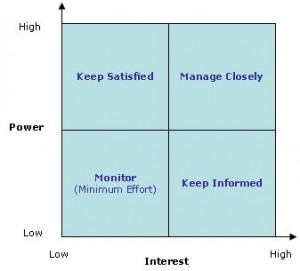To successfully engage with and manage stakeholders throughout a project, it’s very important to be aware of and understand what their ‘stake’ in the project actually is. Stakeholder Analysis is a technique for gathering, documenting and analysing information in order to better understand and appreciate exactly what are your project’s stakeholder’s interests, expectations, impacts and their levels of power and influence.
Once the initial stakeholder identification activity is completed (remembering that this should be an iterative process), you can begin stakeholder analysis. This requires you to exam each stakeholder or stakeholder group to gather more information to better understand each of their unique levels of project influence, interest, expectations and involvement. Undertaking this activity provides you with a deeper understanding of your stakeholders and allows you to start planning and developing engagement and communication strategies. It can also provide other benefits such as helping you to predict how stakeholders may react to various project scenarios or outcomes.
To get started with stakeholder analysis, you can use a variety of questions to assist with gathering and documenting stakeholder information. It’s recommended that where possible, that you undertake this activity in liaison with relevant subject matters experts or even better, to meet, discuss and verify this information directly with each stakeholder or representative of a stakeholder group. Sample stakeholder analysis questions are:
- What is their direct or indirect involvement in the project?
- Will they be negatively or positively impacted by the project work or its outcomes?
- Are they supportive, neutral or critical of the project?
- Will they receive any benefits from the project outcomes?
- Do they agree with the project scope, approach and timeframes?
- Do they have any influence with the management team, project decision makers, government representatives, regulators or media?
- What level of relevant subject matter expertise and experience do they have?
- Do they have any economic, social or community concerns with the project?
- Do they have the ability to stop, delay or significantly change the scope of this project?
A common method to provide you with a summary of your stakeholder’s level of power and interest is to map them in a grid which shows each stakeholder’s relationship with the project. It illustrates each stakeholder’s levels of interest and power (which can be positive or negative) from high to low. A typical example of this type of stakeholder grid is as follows:
A stakeholder with a low level of interest may be someone who will be minimally impacted and does not really care about the project. A stakeholder with a higher level of interest might be an ongoing and active end-user of a product being developed by the project. A stakeholder with limited ability to influence the project will have low power and a stakeholder who, for example, can exert their influence to change, delay or stop a project will have high power.
The data gathered from analysing stakeholders helps you categorise stakeholders and provide you with information to help you to plan and manage your stakeholder communications and engagements. It can also be a very useful tool and source of information for risk, scope and time management activities.


